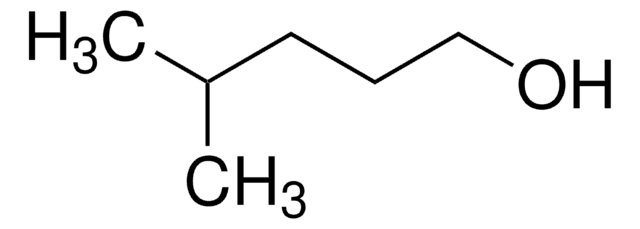320021
3-Methyl-1-butanol
ACS reagent, ≥98.5%
Synonyme(s) :
Isoamyl alcohol, Isopentyl alcohol
About This Item
Produits recommandés
Qualité
ACS reagent
Densité de vapeur
3 (vs air)
Pression de vapeur
2 mmHg ( 20 °C)
Pureté
≥98.5%
Forme
liquid
Température d'inflammation spontanée
644 °F
Limite d'explosivité
1.2-9 %, 100 °F
Impuretés
≤0.002 meq/g Titr. acid
≤0.1% carbonyl (as HCHO)
≤0.2% acids and esters (as amyl acetate)
≤0.5% water
Résidus d'évap.
≤0.003%
Indice de réfraction
n20/D 1.406 (lit.)
pH
5.6 (20 °C, 25 g/L)
Point d'ébullition
130 °C (lit.)
Pf
−117 °C (lit.)
Densité
0.809 g/mL at 25 °C (lit.)
Chaîne SMILES
CC(C)CCO
InChI
1S/C5H12O/c1-5(2)3-4-6/h5-6H,3-4H2,1-2H3
Clé InChI
PHTQWCKDNZKARW-UHFFFAOYSA-N
Vous recherchez des produits similaires ? Visite Guide de comparaison des produits
Catégories apparentées
Description générale
Application
- Dissolution of a wide range of organic compounds and is often employed for extraction, dilution, and preparation of samples for analysis.
- Starting material or reagent in organic synthesis. It can be incorporated into various reactions to introduce the isoamyl group or alcohol functionality into target molecules.
Mention d'avertissement
Danger
Mentions de danger
Classification des risques
Acute Tox. 4 Inhalation - Eye Dam. 1 - Flam. Liq. 3 - Skin Irrit. 2 - STOT SE 3
Organes cibles
Respiratory system
Code de la classe de stockage
3 - Flammable liquids
Classe de danger pour l'eau (WGK)
WGK 1
Point d'éclair (°F)
110.3 °F - closed cup
Point d'éclair (°C)
43.5 °C - closed cup
Certificats d'analyse (COA)
Recherchez un Certificats d'analyse (COA) en saisissant le numéro de lot du produit. Les numéros de lot figurent sur l'étiquette du produit après les mots "Lot" ou "Batch".
Déjà en possession de ce produit ?
Retrouvez la documentation relative aux produits que vous avez récemment achetés dans la Bibliothèque de documents.
Les clients ont également consulté
Notre équipe de scientifiques dispose d'une expérience dans tous les secteurs de la recherche, notamment en sciences de la vie, science des matériaux, synthèse chimique, chromatographie, analyse et dans de nombreux autres domaines..
Contacter notre Service technique






